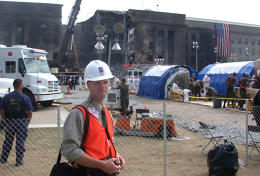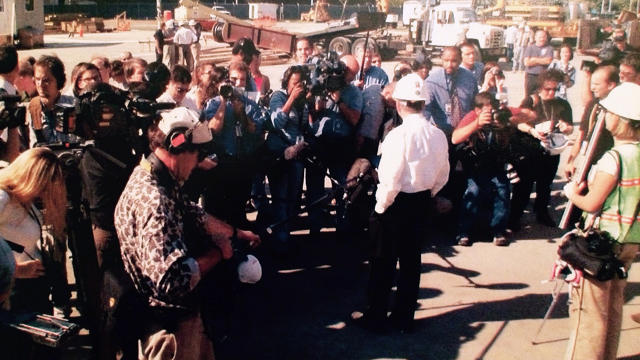What I Learned Working At The Pentagon In The Days After 9/11
On September 11, 2001, I was working a low-level contract job at the Pentagon. In the aftermath of the attack that killed 184 people, I found myself thrust into a leadership position for which I was unprepared. Looking back 15 years later, here’s what that experience taught me.
October 5, 2001
It was early in my career, and I was helping run public relations for the architecture and engineering firm that was managing the Pentagon’s the first-ever major renovation. On 9/11, American Airlines Flight 77 struck the area of the building we’d just finished renovating, with the damage extending into the wing where new work was just beginning. The impact, explosion, fire, smoke, and water damaged nearly 2 million square feet of space—twice the size of the U.S. Capitol Building. From the exterior of the Pentagon, though, you’d never know just how bad it was.
That’s where my team came in. In the immediate aftermath of the terrorist attacks, security was a top priority. As a result, very few members of the news media had been allowed inside the damaged areas as FBI gathered evidence. But on the day the FBI turned control of the crash site over to the Department of Defense, I was responsible for organizing the first press briefing of the area, which would let the media see for the first time the true scope of the mess before demolition and reconstruction work got underway.

So on the afternoon of October 5, 2001, the Pentagon Police opened the gates to the crash site. I waited in a small clearing that allowed a good view of the airplane’s point of impact. I was accompanied by Lee Evey, the Pentagon Renovation Program Manager. We’d put together a few presentation boards to help tell our story—but nothing else. No riser, no microphone, no prepared statement. After all, this wasn’t a press conference, just a photoshoot for maybe a dozen reporters in the Pentagon press corps.
That’s what I thought, anyway, until the news media machine stormed through the gates.
I estimated there were at least 50 reporters, camera operators, and photographers, but it was impossible to get a clear headcount as they pushed and shoved each other, fighting for the best position close to Lee. After a few moments of chaos, he put his fingers between his teeth and silenced the horde with an ear-piercing whistle.
At around the 0:35 mark of the C-SPAN video from that day, Lee says, “Normally when a group comes up here, we give them a little briefing. That may not be what you want to do. What is it you’re expecting here?”
They expected a briefing. They expected a tour. They expected a voice of leadership in a time of fear. I’d failed to prepare Lee for this opportunity, but he rolled into his pitch, taking a pen from his pocket to point to the presentation board. He was knowledgeable, personable, and in charge. He answered questions and we took the group—still pushing and shoving—inside the Pentagon with a warning to watch their step and look out for falling debris. We finished the day with no significant injuries and positive media coverage of the work we were about to undertake.
From my perspective, it was a disaster. I had unintentionally set my boss up to be embarrassed on national television. Lee shined in the spotlight anyway—despite my fumbling the ball PR-wise, not because of it. I thought this might be my first and last press conference. I waited for Lee to come down on me.
Instead, he said, “Next time, prepare as if you’re in charge.”
1. “Prepare As If You’re In Charge”
I know now that to prepare as if you’re in charge is different than to pretend as if you’re in charge, which suggests you just start telling people what to do. It’s also different than simply over-preparing, like you’re cramming for a final exam. To prepare as if you’re in charge requires anticipating risks and opportunities as though you’re the only person accountable for what happens.

It would be years later before I understood all of this deeply, but I internalized at least the gist of Lee’s advice right away. So the next time I was asked to prepare a media opportunity, I prepared as if I would deliver it myself. I confirmed the data and understood it well enough to defend the figures. I rehearsed what I would say to make sure the timing was on point. I asked questions of colleagues to understand the benefits of design-build contracting.
I prepared as if I myself were Lee Evey, about to stand in front of reporters, and I made sure I knew who they were and what they expected. And sure enough, just few weeks later, I was the one in front of the cameras. This time, I was ready to be.
2. If You’re Given A Chance To Lead, Embrace It
At the time, I assumed Lee simply had more important matters demanding his attention than hiring someone to replace me. Only years later did I realize that by empowering me, he’d pushed me knowingly into a leadership role.
Soon enough, I was empowered to represent the Pentagon Renovation Program as the keynote speaker at national conferences, and to give briefings and tours of construction activity to members of Congress, foreign ministers of defense, and celebrities on USO tours. The enormity of my responsibility was never lost on me.
I learned that people who are already inclined to lead still benefit from the explicit permission to do so—even if they aren’t 100% prepared for it at first. If you’re given that opportunity, embrace it.
3. Adapt, Adapt, Adapt
Bruce Lee famously said, “Be water, my friend.” Lee Evey said, “What is it you’re expecting here?” Both understood the power—and necessity—of adapting.
We tend to think of strong leaders as people with tremendous resolve, singular focus, maybe even stubborn to a fault. But this view diminishes leaders who excel because they strive to learn, improve, and grow alongside their teams. They roll with the punches. They’re fluid.
After the Pentagon was rebuilt and the renovation was back on schedule, I was asked to create a new communications function for the Director of Administration and Management for the Office of the Secretary of Defense, a position colloquially known as “The Mayor of the Pentagon.” Since I was starting from scratch, the opportunity required adapting as I went along.
That October morning, Lee Evey showed me what adaptation looks like. It was in the weeks, months, and years afterward that I learned how to do it myself.
Brett Eaton is the Associate Vice President for Communications and External Relations at Wake Forest University. Follow him on Twitter at @bretteaton.
Fast Company , Read Full Story
(16)


